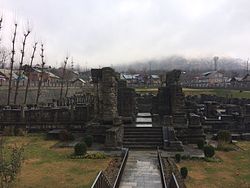This article's tone or style may not reflect the encyclopedic tone used on Wikipedia.(March 2022) |
| Avantiswami Temple | |
|---|---|
 Remains of Avantiswami Temple | |
| Religion | |
| Affiliation | Hinduism |
| District | Pulwama |
| Deity | |
| Governing body | Indian Archaeological Survey |
| Location | |
| Location | Awantipora |
| State | Jammu and Kashmir |
| Country | India |
| Geographic coordinates | 33°55′24″N75°00′46″E / 33.9232602°N 75.012846°E |
| Architecture | |
| Type | Medieval Hindu |
| Founder | Avantivarman |
| Date established | 9th century CE |
The Avantiswami Temple is a ruined Hindu temple complex situated on the banks of the Jhelum River, approximately 28km southeast ofSrinagar, in Awantipora, Jammu and Kashmir, India. This site originally comprised two temples, one dedicated to Shiva and the other to Vishnu, [1] built during the reign of King Avantivarman of the Utpala dynasty in the 9th century CE. Today, the ruins are protected by the Archaeological Survey of India. [2] [3] Locals call the temple Pandav Lari, meaning "house of the Pandavas". [4]




